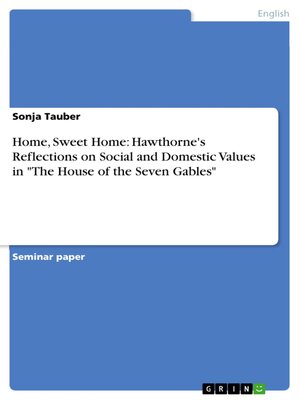Home, Sweet Home
ebook ∣ Hawthorne's Reflections on Social and Domestic Values in "The House of the Seven Gables"
By Sonja Tauber

Sign up to save your library
With an OverDrive account, you can save your favorite libraries for at-a-glance information about availability. Find out more about OverDrive accounts.
Find this title in Libby, the library reading app by OverDrive.



Search for a digital library with this title
Title found at these libraries:
| Library Name | Distance |
|---|---|
| Loading... |
Seminar paper from the year 2008 in the subject American Studies - Literature, grade: 1,0, University of Hamburg (Institut für Anglistik und Amerikanistik), course: Nathaniel Hawthorne and American History, language: English, abstract: Nathaniel Hawthorne may be best known for his first novel, "The Scarlett Letter", which is also considered to be the author's masterpiece. Hawthorne's second novel, in contrast, has often raised heated debates among critics. Unlike its literary forerunner, "The House of the Seven Gables" provides the reader with a rather cheerful ending. Soon after its first publication, most readers responded positively to the novel's closure, since they were "already accustomed to the conventions of the domestic novel" (Gallagher 1989: 10). Sophia Hawthorne clearly favoured her husband's second novel and praised the tale's ending for its deep-seated "home-loveliness". Some years later, however, the reviews became less enthusiastic. Many critics began to complain about its rather optimistic and conservative closure. It was often argued that the novel's cheerful ending "[...] fails to offer a resolution to the social problems" (Goddu 1991:119), which the author so anxiously denounces beforehand. Some modern reviews also accuse Hawthorne of re-establishing hereditary rights in his novel's ending – and thereby affirming the power of the wealthy. The following paper will examine the social and domestic values offered in the "The House of the Seven Gables", in order to re-evaluate Hawthorne's narrative in the context of its time. Since the novel's historical dimension cannot be ignored, this work will also review the importance of the house in antebellum America with regard to its public and private function.







